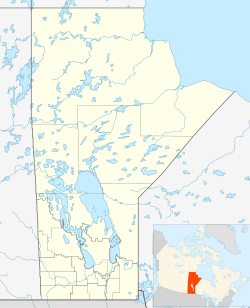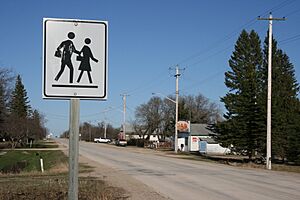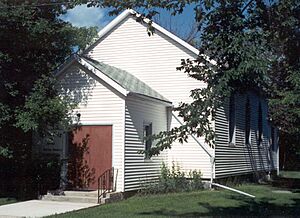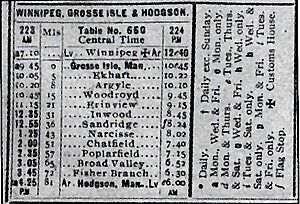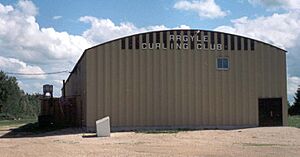Argyle, Manitoba facts for kids
Quick facts for kids
Argyle, Manitoba
|
|
|---|---|
|
Unincorporated Hamlet
|
|
| Motto(s):
Small Community, Big Heart
|
|
| Country | |
| Province | |
| Region | Winnipeg Capital Region |
| Rural Municipality | Rockwood, Woodlands |
| Hamlet began | 1912 |
| Elevation | 252 m (827 ft) |
| Time zone | UTC-6 (CST) |
| • Summer (DST) | UTC-5 (CDT) |
| Postal Code |
R0C 0B0
|
| Area code(s) | 204 |
Argyle is a small community, also called a hamlet, located in the Canadian province of Manitoba. It's found in Manitoba's Interlake Region. Argyle is part of the Rural Municipality of Rockwood. It is very close to the Rural Municipality of Woodlands to the west.
Argyle is about 30 kilometers (18 miles) from Winnipeg, which is Manitoba's capital city. Other nearby towns include Stonewall, Balmoral, and Selkirk. The main activity here is farming, especially mixed farming (growing crops and raising animals). Many people who live in Argyle also work in Winnipeg or other nearby towns.
Contents
Where is Argyle Located?
Argyle is in a special spot because of the Principal Meridian of Canada. This imaginary line divides Eastern and Western Canada. It also marks the border between Argyle and Brant Districts, and between the Rockwood and Woodlands Municipalities. Because people lived on both sides of this line, some local places are named "Brant-Argyle."
The Prime Meridian was important in the 1870s. Surveyors used it as a starting point to map out Western Canada. It helped create the system for naming properties across the prairies.
Just north of Argyle, you can find an old beach ridge from Lake Agassiz. About 10,000 years ago, this huge lake, left behind by melting glaciers, started to drain. It left behind gravel and sand deposits that were once its beaches. These ridges show the northern edge of the Red River Valley. This area has many gravel pits because of these deposits.
The community is about 30 minutes north of Winnipeg. You can get there by taking Highway 67 from Stonewall. The area around Argyle has many farms and gravel companies. It also has thick forests and lots of wildlife.
Who Settled Argyle?
European pioneers started settling in Argyle in the late 1870s. Most of them received 160 acres (0.65 square kilometers) of free land from the Canadian Government. This land grant was a way to encourage European farmers to move to the vast prairies. It helped the Canadian government claim the land between Ontario and the Pacific Ocean.
The first settlers came from Argyllshire, Scotland. They named the district Argyle to honor their old home. The area next to it was called Brant. This name was given by settlers from Ontario. They honored Joseph Brant, a famous Mohawk leader who helped the British during the American War of Independence.
In 1878, residents started gathering at the Guthrie home for church services. In 1881, they built a small church on the east side of the Prime Meridian. It was called Brant-Argyle Presbyterian Church. The land around the church became a cemetery. The earliest settlers were buried there.
The Brant-Argyle Cemetery is where local people are buried. It also has a memorial for soldiers from World War I and World War II, called the Brant-Argyle Cenotaph. A small model of the old church and a historic cairn (a pile of stones) are also at the cemetery. The church building has since been changed into a home.
In 1878, Thomas Guthrie opened the first post office in the Argyle District. At first, he had to walk to Stonewall to get the mail. Later, in 1882, he picked up mail that arrived by train in Marquette. He reportedly earned $50 a year as postmaster and an extra $12 a month for carrying the mail.
Brant-Argyle School
In 1882, small one-room schools were built for the children of the settlers.
- Bruce School was built in the east part of the Brant district. It was named after Joseph Bruce, an early settler. This school was special because it was made of field stone. Most one-room schools back then were made of wood so they could be moved easily.
- McLeod School was named after Dugald McLeod. He was a local leader and one of the first residents in the area.
- Argyle School was the third original school.
These three schools eventually joined together in 1914. They formed the Brant Consolidated School, which was later renamed Brant-Argyle School.
Brant-Argyle School is a four-room brick school. It is unique because it's still used as a school today. It serves the children of the local community. Since 2003, the school has been protected by a Heritage agreement. This means it cannot be torn down or changed much. As of June 2015, about 60 students attended the school. It can hold up to 100 students. This school teaches children from kindergarten to grade 8 in multi-grade classrooms.
The Railway's Arrival
In 1912, the Canadian Northern Railway built a small railway line. It branched off at Grosse Isle and headed north. In its first year, the railway reached a gravel pit. The next year, this new line went through the Argyle and Brant Districts. It ended at Woodroyd, Manitoba. Eventually, the line was built all the way to Hodgson. It followed a zig-zag path to pass close to existing communities.
When the railway came to the Argyle District, there was already a church, a post office, homes, and farms. Since these were spread out, the closest train stop was called Argyle Station. This helped tell the difference between the train station and the nearby post office.
With the railway's arrival, new businesses and buildings appeared. These included the J.D. Douglas General Store, a blacksmith shop, the railway station, a grain elevator, and stock yards. Over the next few years, the post office moved to Argyle Village. More homes were built. The new Brant Consolidated School was also built in 1914. This school brought together the three smaller schools in the region.
The railway made it much easier to ship goods to and from Argyle. In 1919, the Canadian National Railway (CNR) took over the line. They operated it until 1991. The railway truly helped Argyle survive and grow for a long time. Today, the old railway path is a trail for hikers, bikers, and snowmobilers. It's called the Prime Meridian Trail.
Argyle Today
In 2003, the Brant-Argyle School was named a Provincial Historic Site. This means it's recognized as one of the last consolidated schools in the province. It's also a great example of its style.
Argyle is home to North American Rail Products Inc. This company supplies products for railways. They use the building that was once Leo's Sales & Service.
There is one business left in Argyle, which is the general store. It's located between the Argyle Memorial Community Hall and the Argyle Curling Rink. These places are still used by the community and people from nearby areas.
Settlers, Rails & Trails Inc. is a museum located in Argyle. It started in 1991 as the Argyle Prairie Museum. It is now a non-profit organization run by the community. The museum is currently in the Argyle Community Centre. It is waiting to find a permanent home. The museum has a famous Canadian Flag Collection. It is known for being the second largest museum flag collection in Canada. As of March 2017, it has over 1,300 flags. These flags show Canada's history, regions, sports, companies, and special events.
Argyle in Films and TV
Argyle's unique small-town look has been featured in movies.
- The Good Life (2007), starring Bill Paxton, was partly filmed here. The Argyle General Store was used as a bus stop set.
- Pioneer Quest: A Year in the Real West (2000) was filmed entirely in the Argyle area. This reality TV series showed two couples, the Logies and Treadways. Most of the buildings built for the show are still standing today. The property is northeast of the village.
- The Parts You Lose (2019) was partly filmed at the Brant-Argyle School. This happened for three days in January 2018.
Festivals & Celebrations
The community of Argyle has celebrated many important events over the years:
- In 1970, the Brant-Argyle School held a school reunion. It included meals, parades, and historic displays.
- In 1978, the Brant-Argyle United Church celebrated its 100th Anniversary. A Sunday church service ended a weekend of activities.
- In 2000, the Brant-Argyle Homecoming was celebrated. It was a three-day event with a parade, a social dance, breakfast, and historic displays.
- In 2012, the village of Argyle celebrated its 100th Anniversary. It was a one-day event with activities, speeches, entertainment, and historic displays.
- In October 2014, the Brant-Argyle School celebrated its 100th anniversary. There were speeches, entertainment, and historic displays at the school.


